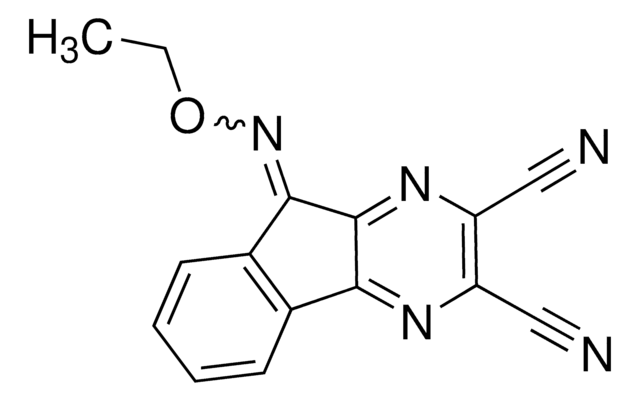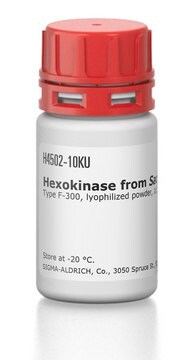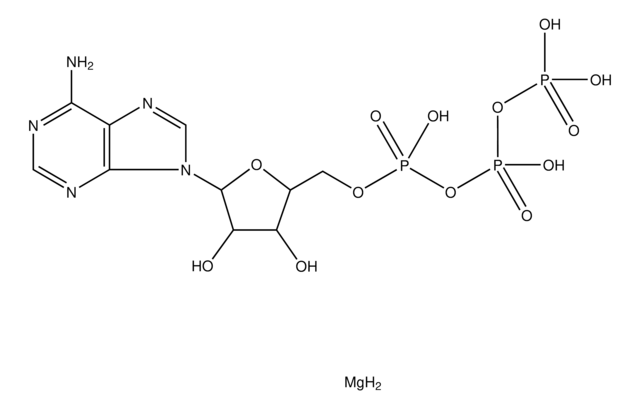SRP6065
Hexokinase 1 human
recombinant, expressed in E. coli, ≥90% (SDS-PAGE)
Sinónimos:
Brain form hexokinase, HK1, Hexokinase type I, N/A
Iniciar sesiónpara Ver la Fijación de precios por contrato y de la organización
About This Item
Productos recomendados
biological source
human
recombinant
expressed in E. coli
assay
≥90% (SDS-PAGE)
form
liquid
potency
7-8 units/mL
mol wt
104.6 kDa
packaging
pkg of 100 μg
storage condition
avoid repeated freeze/thaw cycles
NCBI accession no.
UniProt accession no.
shipped in
dry ice
storage temp.
−70°C
Gene Information
human ... HXK1(3098)
General description
Hexokinase exists as three isozymes, namely type I, type II and type III that differ in subcellular localization, catalytic and regulatory properties. The type I isozyme serves a catabolic function facilitating the entry of glucose into glycolytic metabolism for energy production. The type II and type III enzymes perform anabolic functions, such as generating G6P for glycogen synthesis or metabolism through the phosphogluconate pathway for lipid synthesis. Type I and type II isozymes have been found to be bound to mitochondria. The type III isozyme has been found to have perinuclear localization in several cell types.
Biochem/physiol Actions
Hexokinase catalyzes the conversion of hexoses to hexose-6-phosphate in an ATP-dependent manner. It is also called the glycolytic enzyme as it catalyzes the first step in glucose metabolism with the formation of glucose-6-phosphate (G6P). In eukaryotes, it functions as a glucose sensor.
Physical form
1 mg/mL solution in 20 mM Tris-HCl buffer (pH 8.0) containing 10% glycerol.
Preparation Note
Centrifuge the vial prior to opening.
Other Notes
MGSSHHHHHH SSGLVPRGSH MIAAQLLAYY FTELKDDQVK KIDKYLYAMR LSDETLIDIM TRFRKEMKNG LSRDFNPTAT VKMLPTFVRS IPDGSEKGDF IALDLGGSSF RILRVQVNHE KNQNVHMESE VYDTPENIVH GSGSQLFDHV AECLGDFMEK RKIKDKKLPV GFTFSFPCQQ SKIDEAILIT WTKRFKASGV EGADVVKLLN KAIKKRGDYD ANIVAVVNDT VGTMMTCGYD DQHCEVGLII GTGTNACYME ELRHIDLVEG DEGRMCINTE WGAFGDDGSL EDIRTEFDRE IDRGSLNPGK QLFEKMVSGM YLGELVRLIL VKMAKEGLLF EGRITPELLT RGKFNTSDVS AIEKNKEGLH NAKEILTRLG VEPSDDDCVS VQHVCTIVSF RSANLVAATL GAILNRLRDN KGTPRLRTTV GVDGSLYKTH PQYSRRFHKT LRRLVPDSDV RFLLSESGSG KGAAMVTAVA YRLAEQHRQI EETLAHFHLT KDMLLEVKKR MRAEMELGLR KQTHNNAVVK MLPSFVRRTP DGTENGDFLA LDLGGTNFRV LLVKIRSGKK RTVEMHNKIY AIPIEIMQGT GEELFDHIVS CISDFLDYMG IKGPRMPLGF TFSFPCQQTS LDAGILITWT KGFKATDCVG HDVVTLLRDA IKRREEFDLD VVAVVNDTVG TMMTCAYEEP TCEVGLIVGT GSNACYMEEM KNVEMVEGDQ GQMCINMEWG AFGDNGCLDD IRTHYDRLVD EYSLNAGKQR YEKMISGMYL GEIVRNILID FTKKGFLFRG QISETLKTRG IFETKFLSQI ESDRLALLQV RAILQQLGLN STCDDSILVK TVCGVVSRRA AQLCGAGMAA VVDKIRENRG LDRLNVTVGV DGTLYKLHPH FSRIMHQTVK ELSPKCNVSF LLSEDGSGKG AALITAVGVR LRTEASS
Storage Class
11 - Combustible Solids
wgk_germany
WGK 3
flash_point_f
Not applicable
flash_point_c
Not applicable
Elija entre una de las versiones más recientes:
Certificados de análisis (COA)
Lot/Batch Number
¿No ve la versión correcta?
Si necesita una versión concreta, puede buscar un certificado específico por el número de lote.
¿Ya tiene este producto?
Encuentre la documentación para los productos que ha comprado recientemente en la Biblioteca de documentos.
Isozymes of mammalian hexokinase: structure, subcellular localization and metabolic function.
Isozymes of mammalian hexokinase: structure, subcellular localization and metabolic function.
Isozymes of mammalian hexokinase: structure, subcellular localization and metabolic function.
Wilson JE
The Journal of Experimental Biology, 206 (2003)
Hexokinase as a sugar sensor in higher plants.
Jang JC
Plant Cell (1997)
Nuestro equipo de científicos tiene experiencia en todas las áreas de investigación: Ciencias de la vida, Ciencia de los materiales, Síntesis química, Cromatografía, Analítica y muchas otras.
Póngase en contacto con el Servicio técnico








